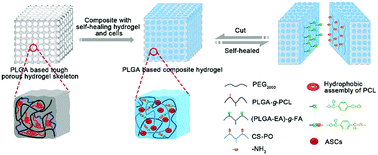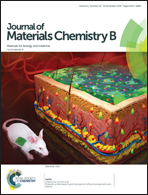A tough and self-healing poly(l-glutamic acid)-based composite hydrogel for tissue engineering†
Abstract
A hydrogel with excellent mechanical properties and self-healing ability provides a promising tool for the repair of load-bearing tissues under a dynamic microenvironment. In this study, poly(L-glutamic acid) (PLGA)-based composite hydrogels with good toughness and self-healing ability were fabricated via filling soft self-healing hydrogels into a tough porous hydrogel skeleton. The PLGA-based tough porous hydrogel skeleton was treated by laser ablation to form a uniform porous structure with 85% porosity and 260 μm pore diameter, and the structure formation was reinforced by the hydrophobic assembly mechanism. The resulting hydrogel skeleton possessed good toughness (maximum compressive stress of 0.51 MPa with strain of 80%) and could fully recover after cyclic compression tests. Furthermore, PLGA-based self-healing hydrogels were fabricated based on a Schiff base reaction, followed by being composited with a tough porous hydrogel skeleton. More importantly, the composite hydrogel exhibited a homogenous interpenetrated structure that inherited mechanical strength and the self-healing ability of the two original compositions. These composite hydrogels exhibited a compressive failure stress of 0.21 MPa at a 63% strain, which was 1.3-fold higher than the value of the original porous hydrogel skeleton at 63% strain. The healing percentage gradually reached 81% within 6 h, indicating the good self-healing efficiency. Furthermore, live/dead staining images revealed that 89% of laden cells remained alive after culture for 7 days. Moreover, the composite hydrogel could self-heal even after cell encapsulation. The developed PLGA-based composite hydrogel will be a promising biomaterial for the repair of load-bearing tissues.



 Please wait while we load your content...
Please wait while we load your content...